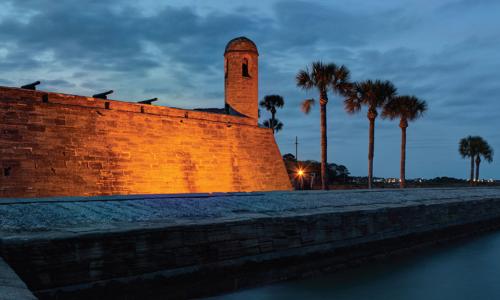Founded in 1630 by English Puritans seeking religious freedom, Boston is one of the oldest cities in the United States and the birthplace of the American Revolution. But in the city where the Sons of Liberty plotted independence from Great Britain, some cherished landmarks and historic districts are at risk from rising seas and worsening storm surges.
Faneuil Hall, which is a stop on Boston’s Freedom Trail and among the nation’s best-preserved historic structures, is one such landmark. Ironically, merchant Peter Faneuil, who built this so-called “Cradle of Liberty” at his own expense, amassed much of his wealth through the slave trade. While the current building dates from 1806, when Charles Bulfinch enlarged Faneuil Hall and moved the cupola, it was first built as a commercial center in 1742 and located on the site of a small cove, which was filled in to accommodate the structure in an area called Dock Square. Over the years, Boston has grown in much this way—through a practice of “wharfing out,” or constructing wharves and then filling them in. Consequently, Faneuil Hall is now a little more than a quarter-mile west of the present shoreline.
Directly to the north of Faneuil Hall is the Blackstone Block, a compact district of narrow winding roads and alleys dating from the seventeenth century. The most intact net- work of early colonial streets in the United States, the district includes the Ebenezer Hancock House and the Union Oyster House, the oldest restaurant in Boston and a favorite of Daniel Webster and John F. Kennedy. Even this far inland, Faneuil Hall and the Blackstone Block are vulnerable, lying within the city’s 100-year tidal flood zone.11 Since official tidal records began in Boston in 1921, extreme high tides—more than three and a half feet above the average high tide—have occurred 20 times, and half of those tides took place within the past 10 years. As a result, several times a year exceptionally high tides already flood parts of the nineteenth-century warehouse neighborhoods around Fort Point Channel and the historic Long and Central wharves.
The public meeting space on the original second floor is what gives Faneuil Hall its fame. Here, Samuel Adams and other Sons of Liberty held public meetings and planned protests against such British colonial policies as the Stamp Act.
It is also the site of the initial meeting about the Tea Act, which prompted the Boston Tea Party. On December 16, 1773, members of the Sons of Liberty disguised themselves as Mo- hawk Indians, boarded three of the British East India Company’s ships, and dumped an estimated 90,000 pounds of tea into Boston Harbor. In response, the British government enacted a series of punitive Coercive Acts (called “Intolerable Acts” by the colonists), including an attempt to limit town meetings such as those held in Faneuil Hall.
Two hundred years after the Declaration of Independence, Faneuil Hall was still used as a place for meetings and other events, but its commercial uses had been discontinued. A 1976 renovation restored the building to its central role in Boston life and served as a model for renewal and revitalization in other US cities. Today Faneuil Hall still houses public forums and serves as the anchor of a robust and vital commercial center.
The City of Boston is highly aware of the dangers posed by sea level rise and heavier rains, and is proactive in planning resilience strategies. The Organisation for Economic Co-operation and Development (OECD) ranked Boston the eighth-highest metropolitan area worldwide in expected economic losses, estimated at $237 million per year between now and 2050, due to coastal flooding. In a 2013 report, the Boston Harbor Association noted that if Hurricane Sandy had hit just five or six hours later, at high tide instead of low tide, more than 6 percent of the city would have been under water. A flood of that magnitude would inundate many of Boston’s coastal neighborhoods, including 65 percent of the Fort Point Channel and Blackstone Block historic districts. As the sea level continues to rise, the risk of major coastal flooding increases.
During the winters of 2013 and 2014, nor’easters caused storm tides to rise even higher than those from Hurricane Sandy in 2012—one rose a foot higher. Yet so far Boston has been lucky, as these storm surges have all coincided with low tides. If the worst of the storm surges had hit at high tide, major flooding could have occurred, inundating much of the waterfront, past Faneuil Hall up to City Hall, and the part of the North End where Paul Revere began his ride.
Boston officials know that they can’t depend on this good fortune to continue indefinitely. Because of sea level rise and other climate threats, including higher temperatures and in- creased smog, the city has embarked on major initiatives to address climate change mitigation and adaptation. Boston has improved its emergency warning systems for flooding, high winds, and winter storms. All new municipal construction must include both an evaluation of climate risks through the year 2050 and a description of ways to avoid, minimize, or mitigate those risks. Other measures include deploying “green” infrastructure (which uses vegetation and soil to manage rainfall and reduce urban heat), better enforcement of flood-proofing building standards, and preparedness for addressing a variety of hazards such as floods, hurricanes, and extreme heat before they occur.
Founded in 1630 by English Puritans seeking religious freedom, Boston is one of the oldest cities in the United States and the birthplace of the American Revolution. But in the city where the Sons of Liberty plotted independence from Great Britain, some cherished landmarks and historic districts are at risk from rising seas and worsening storm surges.
Faneuil Hall, which is a stop on Boston’s Freedom Trail and among the nation’s best-preserved historic structures, is one such landmark. Ironically, merchant Peter Faneuil, who built this so-called “Cradle of Liberty” at his own expense, amassed much of his wealth through the slave trade.7 While the current building dates from 1806, when Charles Bulfinch enlarged Faneuil Hall and moved the cupola, it was first built as a commercial center in 1742 and located on the site of a small cove, which was filled in to accommodate the structure in an area called Dock Square. Over the years, Boston has grown in much this way—through a practice of “wharfing out,” or constructing wharves and then filling them in. Consequently, Faneuil Hall is now a little more than a quarter-mile west of the present shoreline.
Directly to the north of Faneuil Hall is the Blackstone Block, a compact district of narrow winding roads and alleys dating from the seventeenth century. The most intact net- work of early colonial streets in the United States, the district includes the Ebenezer Hancock House and the Union Oyster House, the oldest restaurant in Boston and a favorite of Daniel Webster and John F. Kennedy. Even this far inland, Faneuil Hall and the Blackstone Block are vulnerable, lying within the city’s 100-year tidal flood zone.11 Since official tidal records began in Boston in 1921, extreme high tides—more than three and a half feet above the average high tide—have occurred 20 times, and half of those tides took place within the past 10 years. As a result, several times a year exception- ally high tides already flood parts of the nineteenth-century warehouse neighborhoods around Fort Point Channel and the historic Long and Central wharves.
The public meeting space on the original second floor is what gives Faneuil Hall its fame. Here, Samuel Adams and other Sons of Liberty held public meetings and planned pro- tests against such British colonial policies as the Stamp Act.
It is also the site of the initial meeting about the Tea Act, which prompted the Boston Tea Party. On December 16, 1773, members of the Sons of Liberty disguised themselves as Mo- hawk Indians, boarded three of the British East India Company’s ships, and dumped an estimated 90,000 pounds of tea into Boston Harbor. In response, the British government enacted a series of punitive Coercive Acts (called “Intolerable Acts” by the colonists), including an attempt to limit town meetings such as those held in Faneuil Hall.
<>Two hundred years after the Declaration of Independence, Faneuil Hall was still used as a place for meetings and other events, but its commercial uses had been discontinued. A 1976 renovation restored the building to its central role in Boston life and served as a model for renewal and revitalization in other American cities. Today Faneuil Hall still houses public forums and serves as the anchor of a robust and vital commercial center.The City of Boston is highly aware of the dangers posed by sea level rise and heavier rains, and is proactive in planning resilience strategies. The Organisation for Economic Co-operation and Development (OECD) ranked Boston the eighth-highest metropolitan area worldwide in expected economic losses, estimated at $237 million per year between now and 2050, due to coastal flooding. In a 2013 report, the Boston Harbor Association noted that if Hurricane Sandy had hit just five or six hours later, at high tide instead of low tide, more than 6 percent of the city would have been under water. A flood of that magnitude would inundate many of Boston’s coastal neighborhoods, including 65 percent of the Fort Point Channel and Blackstone Block historic districts. As the sea level continues to rise, the risk of major coastal flooding increases.
During the winters of 2013 and 2014, nor’easters caused storm tides to rise even higher than those from Hurricane Sandy in 2012—one rose a foot higher. Yet so far Boston has been lucky, as these storm surges have all coincided with low tides. If the worst of the storm surges had hit at high tide, major flooding could have occurred, inundating much of the waterfront, past Faneuil Hall up to City Hall, and the part of the North End where Paul Revere began his ride.
Boston officials know that they can’t depend on this good fortune to continue indefinitely. Because of sea level rise and other climate threats, including higher temperatures and in- creased smog, the city has embarked on major initiatives to address climate change mitigation and adaptation. Boston has improved its emergency warning systems for flooding, high winds, and winter storms. All new municipal construction must include both an evaluation of climate risks through the year 2050 and a description of ways to avoid, minimize, or mitigate those risks. Other measures include deploying “green” infrastructure (which uses vegetation and soil to manage rainfall and reduce urban heat), better enforcement of flood-proofing building standards, and preparedness for addressing a variety of hazards such as floods, hurricanes, and extreme heat before they occur.




